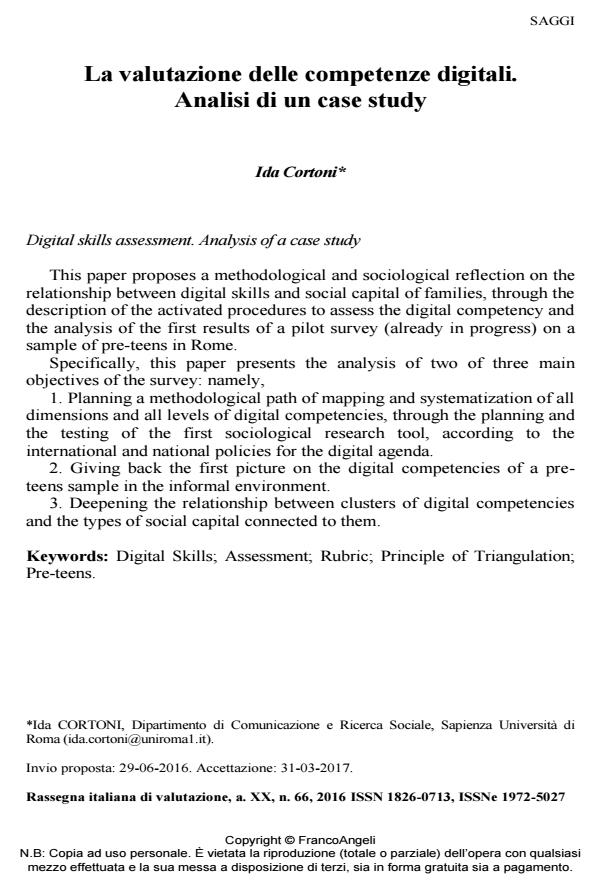Digital skills assessment. Analysis of a case study
Journal title RIV Rassegna Italiana di Valutazione
Author/s Ida Cortoni
Publishing Year 2017 Issue 2016/66 Language Italian
Pages 22 P. 7-28 File size 689 KB
DOI 10.3280/RIV2016-066002
DOI is like a bar code for intellectual property: to have more infomation
click here
Below, you can see the article first page
If you want to buy this article in PDF format, you can do it, following the instructions to buy download credits

FrancoAngeli is member of Publishers International Linking Association, Inc (PILA), a not-for-profit association which run the CrossRef service enabling links to and from online scholarly content.
This paper proposes a methodological and sociological reflection on the relationship between digital skills and social capital of families, through the description of the activated procedures to assess the digital competency and the analysis of the first results of a pilot survey (already in progress) on a sample of pre-teens in Rome. Specifically, this paper presents the analysis of two of three main objectives of the survey: namely, 1. Planning a methodological path of mapping and systematization of all dimensions and all levels of digital competencies, through the planning and the testing of the first sociological research tool, according to the international and national policies for the digital agenda. 2. Giving back the first picture on the digital competencies of a preteens sample in the informal environment. 3. Deepening the relationship between clusters of digital competencies and the types of social capital connected to them.
Keywords: Digital Skills; Assessment; Rubric; Principle of Triangulation; Pre-teens.
- Airasian P.W. (1994). Classroom assessment. NewYork: McGraw-Hill.
- Andò R., Cortoni I. (2013). Media literacy per crescere nell’era digitale. Roma: Armando.
- Aristotele (2000). Etica nicomachea. Milano: Bompiani, VI, 1140 a 24.
- Aufderheide, P. (1993). Media Literacy: A Report Of The National Leadership Conference On Media Literacy. Aspen: Aspen Institute.
- Boyatzis R.E. (1982). The Competent Manager: a model for effective performance. New York: John Wiley & Sons.
- Calvani A., Fini A., Ranieri M. (2010). La competenza digitale nella scuola. modelli e strumenti per valutarla e svilupparla. Brescia: Erickson.
- Castoldi M. (2016). Valutare e certificare le competenze. Roma: Carocci.
- Celot P., Pérez Tornero J. M. (2009). Study on Assessment Criteria for Media Literacy Levels. A comprehensive view of the concept of media literacy and the understanding of how media literacy level in Europe. Brussels: EC.
- Coleman J. (1988). Social Capital in the Creation of Human Capital. The American Journal of Sociology. 94, S95-S120.
- Cortoni I., Lo Presti V. (2015). Digital capabilities. in Kotilainen S. and Kupiainen R., Reflection Media Education Futures. Yearbook, Gotheborg: The International Clearinghouse on Children and Media Nordicom.
- Cortoni I., Lo Presti V., Cervelli P. (2015). Digital Competence Assessment. A Proposal for Operationalizing the Critical Dimension, The journal of Media Literacy education. US: University of Rhode Island.
- Cortoni I., Lo Presti V. (2014). Verso un modello di valutazione delle competenze digitali. Rassegna Italiana di Valutazione. a XVIII, n.60, Milano: FrancoAngeli, pp.7-23.
- Christ, W. G., & Potter, W. J. (1998). Media Literacy, Media Education, And The Academy. Journal Of Communication, 48(1), 5-15.
- Davidson E.J. (2005). Evaluation Methodology Basics: the nuts and bolts of sound evaluation. Ca: Thousand Oaks, Sage.
- Le Boterf G. (2000). Construire les competences individuelles et collectives. Paris: Les Editions Eyrolles.
- Levati W., Saraò M.V. (1998). Il modello delle competenze. Milano: FrancoAngeli.
- Nussbaum M. C. (2000). Women and Human Development: The Capabilities Approach. Cambridge: Cambridge University Press.
- Nussbaum M. C. (2010). Not for Profit. Why Democracy needs the Humanities. Princeton: Princeton University press.
- Palincsar A.S., Brown A. L., Campione J. C. (1991). Dynamic assessment. in Swanson (a cura di), Handbook on the assessment of learning disabilities: theory, research and practice. Austin, pp.75-94.
- Pastore S., Salamida D. (2013). Oltre il “mito educativo”? formative assessment a pratica didattica. Milano: FrancoAngeli.
- Pellerey M. (2006). Dirigere il proprio apprendimento. Autodeterminazione e autoregolazione nei processi di apprendimento. Brescia: La scuola.
- Piaget J., Inhelder B. (1969). The psychology of the child. New York: Basic Books.
- Prellezzo J. M., Malizia G., Nanni C. (2008). Dizionario di Scienze dell’educazione. LAS.
- Putnam R.D., Leonardi R., Nanetti R. Y. (1993). Making democracy work. Civic Tradidion in Modern Italy. Princeton: Princeton University Press.
- Rizza R. e Scidà G. (a cura di) (2003). Capitale sociale e sviluppo. Milano: FrancoAngeli.
- Sen A. (1999). Development as Freedom. Oxford University Press: Oxford.
- Spencer L. M., S. M. Spencer (1993). Competence at work: Models far superior performance. New York: john Wiley & Sons.
- Stame N. (2016), Valutazione pluralista, Franco Angeli, Milano.
- UNESCO: International Symposium on Media Education at Grünwald, Federal Republic of Germany. website: www.unesco.org/education/nfsunesco/pdf/MEDIA_S.PDF.
- UNESCO (2005). Towards Knowledge Societies. Paris: UNESCO World Report.
- Unesco (2008). ICT COMPETENCY STANDARDS FOR TEACHERS. UK: Competence Standards Modules.
- Vergini A. (a cura di) (2013). Prove valutative. il libro bianco della valutazione in Italia. Milano: FrancoAngeli.
- Vygotskij L. S. (1934). Myšlenie i reč. Psicholodičeskie issledovanija. Moskva-Leningrad: Gosudarstvennoe Social’no-Ekonomičeskoe Izdatel’stvo.
- Wiggins G. P. (1998). Educative assessment. Designing assessment to inform and improve student performance. San Francisco, CA: Jossey-Bass.
Ida Cortoni, La valutazione delle competenze digitali. Analisi di un case study in "RIV Rassegna Italiana di Valutazione" 66/2016, pp 7-28, DOI: 10.3280/RIV2016-066002